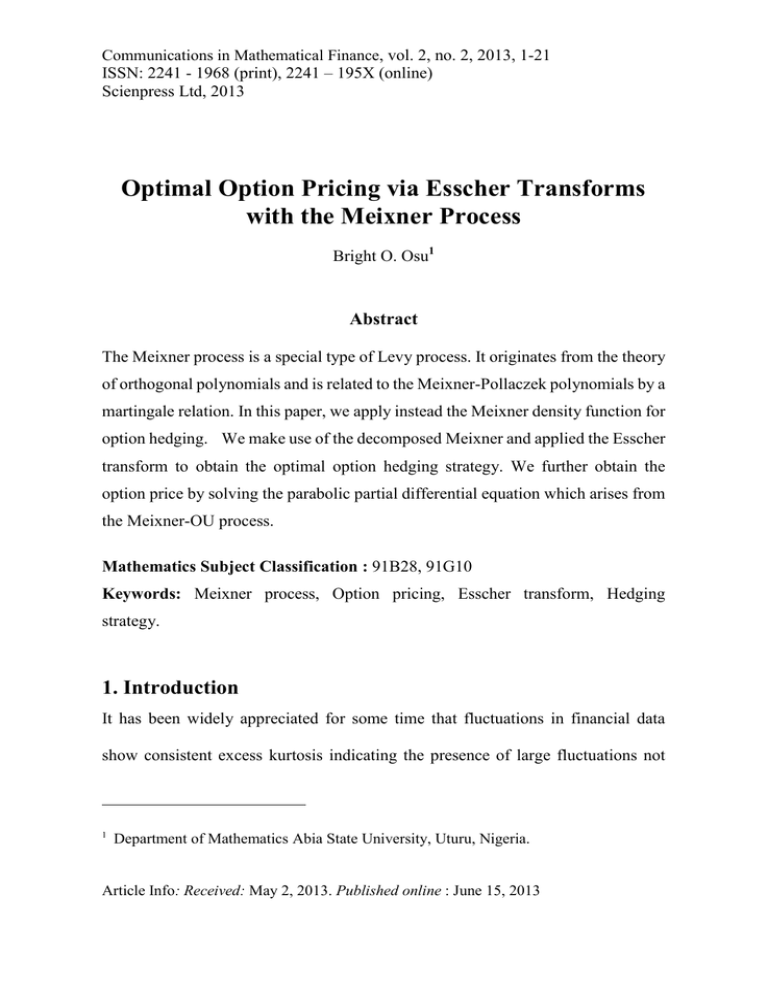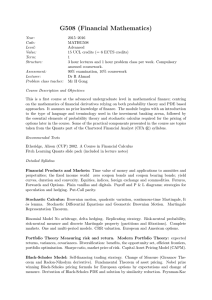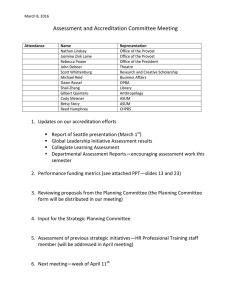Optimal Option Pricing via Esscher Transforms with the Meixner Process Abstract
advertisement

Communications in Mathematical Finance, vol. 2, no. 2, 2013, 1-21
ISSN: 2241 - 1968 (print), 2241 – 195X (online)
Scienpress Ltd, 2013
Optimal Option Pricing via Esscher Transforms
with the Meixner Process
Bright O. Osu1
Abstract
The Meixner process is a special type of Levy process. It originates from the theory
of orthogonal polynomials and is related to the Meixner-Pollaczek polynomials by a
martingale relation. In this paper, we apply instead the Meixner density function for
option hedging. We make use of the decomposed Meixner and applied the Esscher
transform to obtain the optimal option hedging strategy. We further obtain the
option price by solving the parabolic partial differential equation which arises from
the Meixner-OU process.
Mathematics Subject Classification : 91B28, 91G10
Keywords: Meixner process, Option pricing, Esscher transform, Hedging
strategy.
1. Introduction
It has been widely appreciated for some time that fluctuations in financial data
show consistent excess kurtosis indicating the presence of large fluctuations not
1
Department of Mathematics Abia State University, Uturu, Nigeria.
Article Info: Received: May 2, 2013. Published online : June 15, 2013
2
Optimal Option Pricing via Esscher Transforms with the Meixner Process
predicted by Gaussian models. The need for models that can describe these large
events has never greater, with the continual growth in the derivatives industry and
the recent emphasis on better risk management.
Option valuation is one of the most important topics in financial mathematics.
Black and Scholes [1] derived a compact pricing formula for a standard European
call option by formulating explicitly the model on the risk-neutral measure, under
a set of assumptions.
The accurate modeling of financial price series is important for the pricing and
hedging of financial derivatives such as options. Research on option theory with
alternative pricing models has tended to focus on the pricing issue. It is well
known that non- Gaussian pricing models lead to the familiar volatility smile
effect caused by that ‘fat’ tails of the non-Gaussian PDF’s.
To price and hedge derivatives securities it is crucial to have a good modeling of
the probability distribution of the underlying product. The most famous
continuous time model used is the calibrated Black-Scholes model. It uses the
normal distribution to fit the Log-returns of the underlying; the price process of
the underlying is given by the geometric Brownian motion.
(
Where {
)
is a standard Brownian motion ie.
follows a normal
distribution with mean 0 and variance . Its key property is that it is complete (ie
a perfect hedge is an idealized market in theory possible).
Bright O. Osu
3
It is however known that the Log-returns of most financial assets have lean actual
kurtosis that is higher than that of the normal distribution. As a result of the
kurtosis being higher than that of the normal distribution we look into another
distribution that will fit in the data in most perfect way. Empirical evidence has
shown that the normal distribution is a very poor model to fit real life data. In
order to achieve a better fit we replace the Brownian motion by a special Levy
process called the Meixner process. Several authors proposed similar process
models. For example Eberlein and Keller [2] proposed the Hyperbolic Models and
their generalizations. Barndorff – Nielsen [3] proposed the Normal Inverse
Gaussian (NIG) Levy process. Luscher [4] used the NIG to price synthetic
Collateralized Debt Obligations (CDO). Osu et al [5] applied the same model as a
tool to investigate the effect in future, the economy of a developing nation with
poor financial policy.
Our aim in this paper is to apply instead the Meixner density function for option
hedging.
We make use of the decomposed Meixner
with the
application of the Esscher transform to obtain the optimal option hedging strategy.
Furthermore, we obtain the option price by solving the parabolic partial
differential equation which arises from the Meixner-OU process.
2. The Meixner Process
The Meixner distribution belongs to the class of the infinitely divisible
distributions and as such give rise to a Levy process. The Meixner process is very
4
Optimal Option Pricing via Esscher Transforms with the Meixner Process
flexible, has simple structure and leads to analytically and numerically tractable
formulas. The Meixner process originates from the theory of orthogonal
polynomials and was proposed to serve a model of financial data.
The density of the Meixner distribution Meixner
is given by [6]
) ,
where
2.1. Moments
Moments of all order of this distribution exist and is given (and compared to the
Normal distribution) below as
Meixner (
Normal(
⁄
Mean
⁄
Variance
Skewness
Kurtosis
Meixner
( ⁄ )√ ⁄
⁄
0
3
We can clearly see that the kurtosis of the Meixner distribution is always greater
than the normal Kurtosis and stationary increments and where the distribution of
(Meixner process) is given by the Meixner distribution Meixner
.
Figure 1 below compares the performance of the Normal and Meixner
distributions with fictitious financial data.
Bright O. Osu
5
1.5
performance
1
-30
0.5
0
-20
-10
0
10
20
30
-0.5
-1
fictitious Financial data
Figure 1: The Microsoft excel plot of the fictitious market data using the Normal
distribution (blue) and Meixner distribution (green) with the trend (black).
2.1.1. Levy Triple
The Meixner process
̃
has a triplet of Levy character ̃
( ⁄ )
, where
( )
∫
( )
∫
In general a Levy process consists of three independent parts a lower deterministic
part, a Brownian part, and a pure jump part. It can be shown that the Meixner
process
has no Brownian part and a pure jump part governed by the
Levy measure
.
The characteristics function of the Meixner
distribution is given by
6
Optimal Option Pricing via Esscher Transforms with the Meixner Process
[
]
(
( )
(
)
)
2.1.2. Semi Heaviness of Tails
The Meixner (
distribution has semi-Levy tails [7], which means that
the tails of the density function behave as
as
as
for some
,
.For some
,
.
The Levy measure is not finite
The process has an infinite number of jumps.
3. Esscher Transform Method
The Esscher transform [8] was developed to approximate a distribution around a
point of interest, such that the new mean is equal to this point. In actuarial science,
it is a well - known tool in the risk theory literature. In the content of [9], the
Esscher transform becomes an efficient technique for financial options, and other
derivatives, valuation. That is, if the log of the underlying asset prices follows a
stochastic process with stationary and independent increments and given the
assumption of risk neutrality, the risk-neutral probabilities associated with a model
can be calculated.
For a probability distribution function (pdf),
let
be a real number such
Bright O. Osu
7
that
∫
exists.
As a function in
,
is a probability density function and it is called the Esscher Transform of the
original distribution.
3.1. Risk-Neutral Esscher Transform
Let
be a random variable with an infinitely divisible distribution. Thus, its
cumulative distribution function and moment generating function are given by
[
]
and
[
By assuming that
].
is continuous at t=0, it can be proved that
[
].
(3.1)
The density function of this random variable is given by
,
.
Then,
∫
Let
be a real number such that
exists. Gerber and Shiu[9], then
introduced the Esscher transform with parameter
, of the stochastic process
This process has stationary and independent increments. Thus, the new
8
Optimal Option Pricing via Esscher Transforms with the Meixner Process
pdf of
is
(3.2)
∫
The new moment generating function is;
(3.3)
∫
By equation (1),
[
]
(3.4)
To have a risk neutral transform, we see
discounted at the risk-free,
measure corresponding to
, such that the asset pricing
is a Martingale with respect to the probability
. That is
[
]
[ ]
(3.5)
and
(3.6)
Where
is the continuously compounded rate of return over t periods. Using
(3.6) into (3.5), the parameter
is the solution of the equation
[
Thus, we have a value for
].
(3.7)
depending 0n the probability distribution of
by equation (3.4), the solution does not depend on t so we may set
[
]
[
(3.8)
].
(3.9)
Bright O. Osu
9
The Esscher transform of parameter
is called the risk-neutral Esscher
transform, and the corresponding equivalent Martingale measure is called the
risk-neutral Esscher measure.
Although the risk-neutral Esscher measure is
unique, there may be other equivalent Martingale measure.
3.1.1. European Call Option Valuation Using Esscher Transform.
Developing the methodology, [9] assumed the same assumption made by [1]; the
risk-free interest rate is constant; the market is frictionless and trading is
continuous; there are no taxes; no transaction cost; and no restriction on borrowing
or short sales; all assets are perfectly divisible; there are no arbitrage opportunities;
and the assets do not distribute dividends. Harrison and Kreps [10] showed that
the condition of no arbitrage is intimately related to the existence of an equivalent
Martingale measure. The risk-neutral probability measure will be given by the
risk-neutral Esscher transform.
Thus, for a European call option, we have
∫
(3.10)
Assuming that the stock prices are log-normally distributed, let the stochastic
process
be a Weiner process with mean per unit time
and variance per
unit time
Then,
,
and
[
Thus from (3.3)
]
.
(3.11)
10
Optimal Option Pricing via Esscher Transforms with the Meixner Process
)
[(
]
.
(3.12)
Hence the Esscher transform of parameter h of the Weiner process is again a
Weiner process, with modified mean per unit time and unchanged variance per
unit time. Thus,
Using the modified distribution in equation (3.2) and equation (3.6) into (3.10), we
have;
∫
.
(3.13)
( )
Note that the lower bound of the integral is given by
That is to price call options, we only need the rate of returns that produce values
equal or greater than the exercise price. By equation (3.11)
[
(
]
)
.
(3.14)
Rewriting the call option, using equation (13) and (12), we have;
[
∫
]
∫
(3.15)
To solve the expected value of a truncated normal random variable, we apply the
method in [11]. Thus;
(
We can find
(
)
)
(
(
)
for a random variable normally distributed
.
(3.16)
)
, thus;
Bright O. Osu
11
Replacing this in equation (3.16), we obtain,
– (
) (
)
–
(
(
)
).
(3.17)
Thus, from the risk-neutral Esscher transform, we obtain the traditional
Black-Scholes formula for pricing a European call option.
expected rate of return
Note that the
, which represents the preference of investors does not
appear in the final formula.
3.1.2. Equivalent Martingale Measure
According to the fundamental theorem of asset pricing the arbitrage free price
[
of the derivative at time
] is given by
[
|
Where Q is an equivalent Martingale measure ,
of ,
]
is the natural filtration
. An equivalent Martingale measure is a probability measure which is
equivalent (it has the same null-sets) to the given (historical) probability measure
and under which the discounted process
is a Martingale. Unfortunately
for most models, the more realistic ones, the class equivalent measure is rather
large and often covers the full no-arbitrage interval.
In this perspective the Black-Scholes model, where there is a unique equivalent
Martingale measure ism exceptional. Models with more than one equivalent
measure are called incomplete.
Meixner model is such an incomplete model so called Esscher transform easily
find at least one equivalent Martingale measure, which we will use in the sequel
12
Optimal Option Pricing via Esscher Transforms with the Meixner Process
for the valuation of derivatives securities. The choice of the Esscher measure may
be justified by a utility maximizing argument.
The model which provides exactly Meixner
daily log-returns for the
stock is that which replaces the Brownian motion process in the BS-model by a
Meixner process given by
To choose an equivalent Martingale measure we use Esscher transform.
Then choose
is a Martingale under
.We know that
(Martingale condition) when
(
∫
(
∫
With
)
.
)
we get that
∫
(
∫
This gives
{
}
(
( )
so that
)
( )
(
(
)
(
)
)
( )
(
)
(
)
)
.
Bright O. Osu
13
{
{
(
}
( )
( )
)}.
The equivalent Martingale measure is given by
.
And the density equals
∫
{
(
)}
(
(
(
(
))
{
(
)}
).
)
The equivalent Martingale measure
follows again a Meixner
distribution.
4. Optimal Option Hedging with the Meixner Process
The advantage of the Meixner model over the other Levy model is that all crucial
formulas are exactly given so that it is not depending on computationally
demanding numerical inversion proceeds. This numerical advantage can be
important when a big number of prices or related quantities have to be completed
simultaneously.
The process
,
where the process
(4.1)
is a subordinator; more precisely, it is a Levy process with no
Brownian part, non-negative drift and only positive increments. The processes
14
Optimal Option Pricing via Esscher Transforms with the Meixner Process
is called Ornstein-Uhlenbeck(OU) processes [12]. The rate parameter
is arbitrary positive and
(BDLP). The process
the process
function
is the Background Driving Levy Process
is an increasing process and
, it becomes clear that
is strictly positive and bounded from below by the deterministic
.
The Meixner
is self-decomposable [13]. Therefore we have
((
) )
((
) )(
(
))
(4.2)
with cumulant function of the self- decomposable law given as;
((
))
.
(4.3)
The Meixner-OU process is not driven by a BDLP that is a subordinator. The BDLP
has a Levy density that lives over the whole real line. This means that the
Meixner-OU process (and its BDLP) can jump upwards and downwards.
Consider the price
with exercise price
of a European call option at current time
,
due to expire in a time . When the time to expiry is small the
returns and interest rate can be neglected [14]. The option price is then very well
approximated by
⟨
where
⟩
∫
,
is the PDF of the underlying asset price
(4.4)
. Bouchaud and
Sornette [15] and [16] in their approach to option and hedging found that the
wealth variation between times
and
can be written as;
Bright O. Osu
15
̇
∫
,
(4.5)
where the first term is the option premium received at
describes the payoff at expiry
where
, the second term
and the third term describes the effect of the trading
is the amount of stock held.
Giving now the decomposed Meixner
PDF of (4.2) we define its
expected value (or in this case the optimal hedging strategy) as;
(
)
∫
∫
((
) )
((
) )(
(
))
∫
((
) )
((
) )(
(
))
[
{(
) }
{ (
) }
(
)]
(4.6)
Figure 2 below shows expected value (or the optimal hedging strategy) given (4.6).
The pricing for a European call option with respect to the equivalent Martingale
measure equals
∫
∫
[
{(
{ (
) }
) }
(
)]
16
Optimal Option Pricing via Esscher Transforms with the Meixner Process
[
{(
) }
{ (
) }
Figure 2: The expected values for high and small values of
assumptions:
,
,
,
(
)]
(4.7)
under the following
,
(given
the fictitious market data and (4.6)) to the extent that Maple can display in the
interval of the values of
.
Harrison and kreps[10] established a mathematical foundation for the relationship
between the no-arbitrage principle and the notion of risk-neutral valuation using
probability theory. Gerber and Shiu [8] used the Esscher transform to obtain an
equivalent martingale measure which is the risk-neutral probability distribution.
Rewriting the call option, using equation (3.13), we now solve for the expected
value giving now the decomposed Meixner
PDF of (4.2).We apply
the method in [11] to get;
[
[
) }
{(
{(
) }
{ (
{ (
) }
) }
(
)]
(
.
(4.8)
)]
Bright O. Osu
17
Equation (4.8) is the approximate wealth variation or the option price whose
behaviour for the large and little values of
is as in figure 3.
Figure 3: The option price for the large and little values of
Maple can display in the interval of the values of
assumptions:
Assume now
,
,
to the extent that
under the following
,
,
.
follows instead the Orntsein-Uhlenbeck process as in (4.1)
,
with explicit solution
∫
.
(4.9)
Applying the Duhammel principle, equation (4.9) has a Gaussian distribution with
mean
and variance given by
∫
[
]
18
Optimal Option Pricing via Esscher Transforms with the Meixner Process
[
].
(4.10)
Hence (4.10) has a markov process with stationary transition probability densities
[
]
√
This is particularly interesting for
.
(4.11)
, which is the stable case and
,
(4.12)
and
(
√
Thus as
).
(4.13)
.
The price evolution of risky assets are usually modelled as the trajectory of a
diffusion process defined on some underlying probability space
, with the
geometric Brownian motion process the best candidate used as the canonical
reference model. It had been shown in [7] that the geometric Brownian motion can
indeed be justified as the rational expectation equilibrium in a market with
homogenous agents. But the evolution of the stock price process is well known to
be described by the dynamics
,
with unique solution known to be (
and
(4.14)
are the drift and volatility respectively,
assumed continuous functions of time)
{∫
∫
}.
Given equation (4.12), it is not difficult to see that (4.15a) becomes
(4.15a)
Bright O. Osu
19
{∫
}.
By (4.12), we mean that the drift parameter
(4.15b)
and future price of an option depend
on volatility .
Ito’s formula on (4.14) gives;
,
(4.16)
which is the famous Black-Scholes parabolic partial differential equation.
is the value of option(s) or the portfolio value given different option values
with different prices. We shall now solve the PDE (4.16) for stock which are
already priced in the market for the option price. If the volatility follows the generic
process
(where
may be stochastic), the option price will be given by
∫ [
where
]
,
(4.17)
is the probability distribution function for the mean of the volatility
(which is a delta function for a deterministic process) and
and
are the
same variables. Let (for the deterministic case)
.
(4.18)
In this case, the probability distribution function of the mean of the volatility is
given by
(
given the Black-Scholes result where √
)
,
(4.19)
replaces
.
20
Optimal Option Pricing via Esscher Transforms with the Meixner Process
Consider now a stochastic volatility process where
represents white noise so
that;
.
The distribution of the mean of
(4.20)
during the time interval is given by
(
).
(4.21)
Therefore, the option price is given by
∫ [
]
(
)
(4.22)
5. Conclusion
In option theory a major disincentive for using non-Gaussian based models is the
absence of a riskless hedge [14]. This makes it to apply the Black-Scholes option
framework in anything other than an ad hoc way. In this paper we have further
demonstrated the fact that the self-decomposed Meixner density function can be
used to hedge a financial derivative. In solving (4.16) for the price of option, we
have made use of Merton’s theorem that the solution for a deterministic volatility
process is the Black-Scholes price with the volatility variable replaced by the
average volatility.
References
[1] F. Black and M. Scholes, The pricing of options and corporate liabilities,
Journal of political economy, 81, (1973), 637-654.
[2] E. Eberlein and U. Keller, Hyperbolic Distribution in Finance, Bernoulli,
1,(1995), 281-299.
Bright O. Osu
21
[3] O.E. Barndorff – Nielsen, Normal Inverse Gaussian Distributions and the
Modeling of Stock Returns, Technical report, Research Report No. 300,
Department of Theoretical Statistics, Aarhus University, 1995.
[4] A. Luscher, Synthetic CDO pricing using the double normal inverse Gaussian
copula with stochastic factor loadings, Diploma thesis submitted to the ETH
ZURICH and UNIVERSITY OF ZURICH for the degree of MASTER OF
ADVANCED STUDIES IN FINANCE, 2005.
[5] B. O. Osu, O. R. Amamgbo and M. E. Adeosun, Investigating the Effect of
Capital Flight on the Economy of a Developing Nation via the NIG
Distribution , Journal of Computations & Modelling, 2(1), (2012) 77-92.
[6] W. Schoutens, The Meixner process: Theory and Application in Finance,
EURANDOM Report 2002-004. EURANDOM, Eindhoven, 2002.
[7] B. Gigelionis, Generalized z- Distribution and related stochastic processes,
Mathematics institute preprint Nr. 2000-22, Vilnius, 2000.
[8] F. Esscher, On the probability function in the collective. Theory of Risk.
Skandinavisk Aktuarietidskrift, 15, (1932), 175-195.
[9] H. U. Gerber and E. S. W. Shiu, Martingale approach to pricing perpetual
American options, ASTIN Bulletin, 24(2), (1994).
[10] J. M. Harrison and D. M. Kreps, Martingales and Arbitrage in multi-period
securities markets, Journal of Economic Theory, 20, (1979), 381-480.
[11] M. Rubinstein, The valuation of uncertain income streams and the pricing of
options, Bell Journal of Economics, 7, (1976), 407-425.
[12] W. Schoutens, Levy processes in Finance: Pricing Financial Derivatives,
John wiley and Sons, Ltd. ISBN:0-470-85156-2, 2003.
[13] B. Gigelionis, Processes of Meixner type, Lith. Math. Journal, 39(1), (1999)
33-41.
[14] A. Matacz, Financial modelling and option theory with the Truncated Levy
process, Int. J. theoretical and App. Finan., 3(1), (2000), 143-160.


